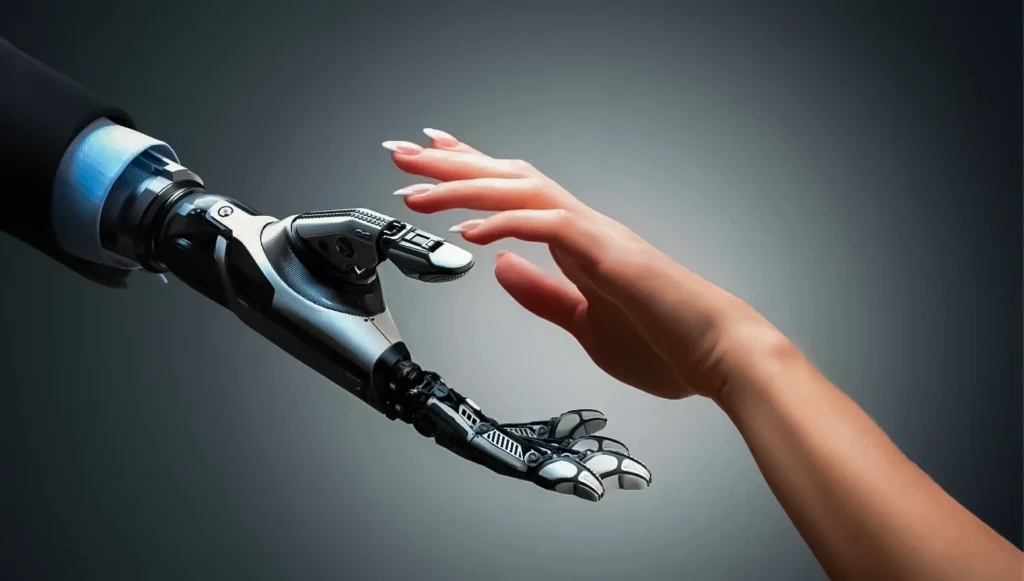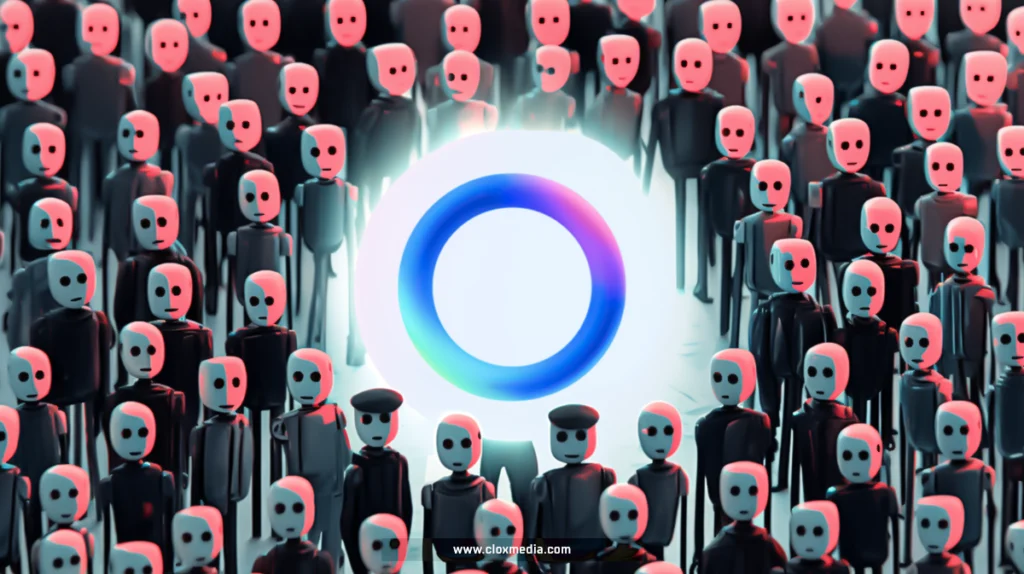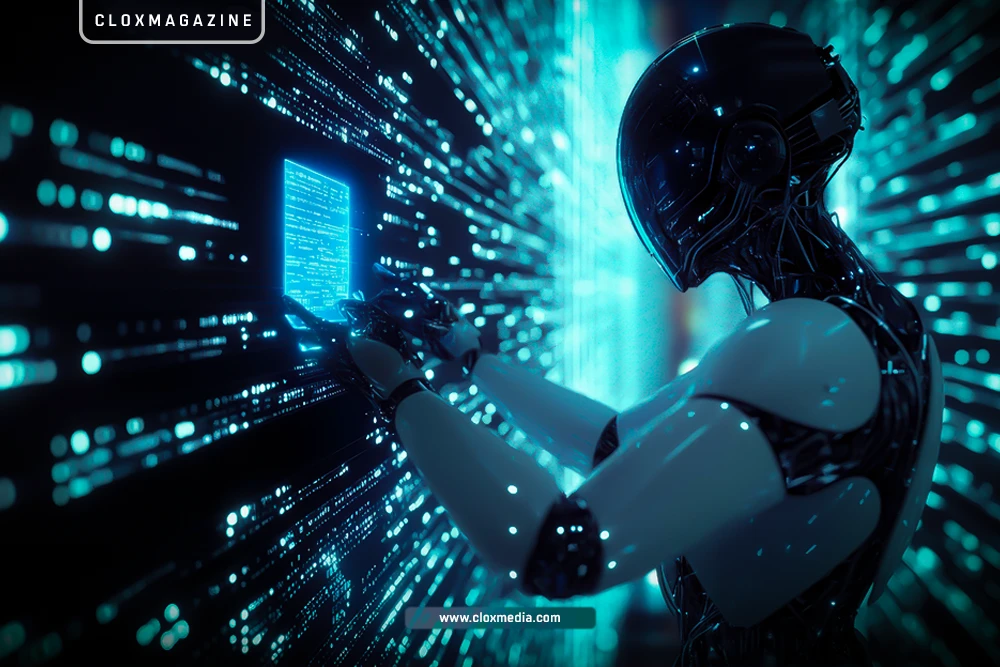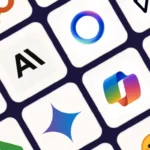Please close your eyes… Imagine for a moment that the smartphone in your pocket could redesign itself overnight, becoming faster, smarter, and more capable without any human intervention. While this sounds like science fiction, we’re actually witnessing the early stages of something far more profound in the world of artificial intelligence. Recent breakthroughs in self-improving AI systems are pushing us toward a future where machines don’t just follow our programming.
Easier to say that they rewrite their own code to become better versions of themselves. This isn’t just another incremental advancement in technology; it’s potentially the most significant leap in AI development since the invention of machine learning itself.
NOTE: This is an official Research Paper by “CLOXLABS“
The Problem With Today’s AI: Smart, But Not Self-Aware
Here’s something that might surprise you: despite all the impressive capabilities of modern AI systems like ChatGPT or autonomous vehicles, they’re essentially sophisticated but static programs. Think of them as incredibly talented performers who can only play the songs they were taught during training. They can’t compose new music or improve their performance based on experience in the real world.
Current AI systems suffer from what researchers call “fixed architectures”—they’re designed by humans and locked into specific patterns of operation. Once deployed, they can’t fundamentally change how they work or develop new capabilities beyond what their creators originally programmed. It’s like having a brilliant student who can answer any question about physics but can never learn a new subject or develop better study methods.
This limitation becomes particularly problematic when we consider the rapid pace of technological change. By the time an AI system is developed, tested, and deployed, the problems it was designed to solve may have evolved significantly. Meanwhile, the system remains frozen in time, unable to adapt its core functioning to meet new challenges or take advantage of better approaches that emerge after its creation.
The implications extend far beyond mere efficiency concerns. If we want AI to help solve humanity’s most pressing challenges —from climate change to disease— we need systems that can continuously evolve and improve their problem-solving abilities. The alternative is a technological landscape where human programmers become the bottleneck for AI advancement, manually updating and redesigning systems in a never-ending cycle that can’t keep pace with the complexity of real-world problems.
… All ADS on this platform are served by GOOGLE …
Enter the Darwin Gödel Machine: Evolution Meets Artificial Intelligence
In May 2025, researchers introduced something remarkable called the Darwin Gödel Machine (DGM), a system that represents perhaps our first serious attempt at creating truly self-improving AI. The name itself tells a fascinating story: it combines Charles Darwin’s principles of evolution with Kurt Gödel’s mathematical insights about self-referential systems.
But what makes the DGM different from previous attempts at self-improving AI? The key insight lies in how it approaches the fundamental challenge of self-modification. Previous theoretical frameworks, like the original Gödel machine concept, required systems to mathematically prove that any change they made to themselves would be beneficial. While elegant in theory, this approach proved impossible in practice—imagine trying to prove mathematically that learning a new language will make you a better person before you’re allowed to start studying.
The DGM takes a more pragmatic, evolution-inspired approach. Instead of demanding mathematical proofs, it uses empirical testing—essentially trial and error with sophisticated safeguards. The system maintains what researchers call an “archive” of different versions of itself, each slightly different from the others. It then creates new variations by sampling from this archive and using foundation models to generate interesting modifications.
Think of it like a master craftsperson who keeps detailed records of every technique they’ve ever tried, noting which ones worked well for different types of projects. When facing a new challenge, they don’t just rely on their standard approach—they experiment with combinations and variations of their best techniques, creating new methods that build upon their accumulated experience. The crucial difference is that the DGM does this automatically and continuously, without human intervention.
How Self-Improving AI Actually Works in Practice
The mechanics of the Darwin Gödel Machine reveal just how sophisticated this self-improvement process has become. Rather than making random changes and hoping for the best, the system follows a structured evolutionary process that mirrors natural selection but operates at the speed of computation.
The DGM begins each improvement cycle by examining its current archive of agent variations, each representing a different approach to solving coding problems1. Using foundation models—the same type of advanced AI that powers modern language models—it selects promising agents and creates new versions that combine successful features in novel ways. This isn’t simply copying existing solutions; it’s genuinely creative recombination that can produce unexpected innovations.
What makes this process particularly powerful is its open-ended nature. Unlike traditional optimization methods that search for a single best solution, the DGM explores multiple promising directions simultaneously. This parallel exploration creates what researchers describe as a “growing tree of diverse, high-quality agents,” each specialized for different aspects of the coding challenges it faces.
… All ADS on this platform are served by GOOGLE …
The empirical validation process ensures that improvements are real, not just theoretical. Each modified version of the system must prove its worth on actual coding benchmarks; standardized tests that measure programming ability. Only modifications that demonstrate genuine improvement become part of the permanent archive. This creates a ratchet effect where the system can only improve over time, never regressing to less capable versions.
The results speak for themselves. In rigorous testing, the DGM improved its performance on the SWE-bench coding challenge from 20.0% to 50.0%—a remarkable 150% improvement. On the Polyglot programming test, performance jumped from 14.2% to 30.7%. These aren’t marginal gains; they represent fundamental improvements in the system’s ability to understand and manipulate code.
The Broader Science of Open-Ended Evolution
To truly understand why self-improving AI represents such a breakthrough, we need to step back and examine the broader scientific concept of open-ended evolution. This phenomenon, observed in both biological and technological systems, refers to the seemingly unlimited capacity for increasing complexity over time.
Consider the evolution of life on Earth. Over billions of years, organisms have grown from simple chemical reactions to the extraordinary complexity of human consciousness, with no apparent upper limit to this process. Similarly, human technology has evolved from stone tools to quantum computers, each generation building upon previous innovations to create capabilities that would have been incomprehensible to earlier generations.
What makes evolution “open-ended” is its ability to continuously discover new possibilities rather than simply optimizing within fixed constraints. Traditional AI systems optimize within the boundaries set by their human designers, but open-ended evolution breaks through these boundaries by discovering entirely new ways of operating. This distinction is crucial because it represents the difference between becoming better at solving known problems and developing the capacity to solve problems that don’t yet exist.
Research has identified three distinct types of open-endedness: exploratory, expansive, and transformational. Exploratory open-endedness involves finding new solutions within existing problem spaces—like discovering more efficient algorithms for known computational tasks. Expansive open-endedness pushes into entirely new domains of behavior, while transformational open-endedness fundamentally changes the nature of the system itself.
The Darwin Gödel Machine primarily demonstrates exploratory open-endedness, continuously finding better ways to approach coding challenges. However, its architecture contains the seeds of more advanced forms of open-endedness. As the system improves its ability to modify its own code, it may eventually develop capabilities that extend far beyond its original programming domain.
The Mathematical Beauty Behind Endless Innovation
One of the most fascinating aspects of open-ended evolution is its mathematical signature. Systems that display this property often follow Zipf’s Law—a statistical pattern where a few elements are extremely common while most are rare. You see this pattern everywhere from word frequencies in languages to the distribution of protein domains in biology.
Using algorithmic information theory, researchers have shown that Zipf’s Law emerges naturally from evolutionary processes that display genuine open-endedness. This creates a powerful diagnostic tool: if we see Zipf’s Law emerging in an artificial system, it suggests that system has achieved true open-ended evolution rather than just sophisticated optimization.
The mathematical framework reveals something profound about information and complexity in evolutionary systems. As these systems generate new information through evolutionary processes, they paradoxically seem to erase previous information through the very act of creation. This apparent contradiction resolves when we consider that different types of information are at play—statistical information may decrease while algorithmic information content increases.
For self-improving AI systems like the Darwin Gödel Machine, this mathematical insight provides both guidance and validation. Systems that achieve genuine open-endedness should show signatures of Zipf’s Law in their internal organization and behavior patterns. More importantly, understanding these mathematical principles helps researchers design systems that can sustain long-term self-improvement without getting trapped in local optima or infinite loops of unproductive modification.
… All ADS on this platform are served by GOOGLE …
Safety First: Keeping Self-Improving AI Under Control
Perhaps the most critical aspect of developing self-improving AI systems is ensuring they remain safe and controllable. The researchers behind the Darwin Gödel Machine were acutely aware of these concerns, implementing multiple layers of safety precautions throughout their experiments.
The primary safety mechanism involves sandboxing; running the self-improving AI in isolated computational environments where it cannot affect external systems or access sensitive resources. Think of it as allowing a powerful but unpredictable animal to roam freely within a carefully designed zoo enclosure. The animal can express its natural behaviors and even modify its environment, but it cannot escape or cause harm to the outside world.
Human oversight represents another crucial safety layer. While the DGM operates autonomously during its self-improvement cycles, human researchers monitor its progress and maintain the ability to halt or redirect the process if unexpected behaviors emerge. This isn’t micromanagement… it’s more like having experienced supervisors who watch apprentices learn new skills, ready to intervene if the learning process takes dangerous turns.
The empirical validation process itself serves as a safety mechanism. Since all modifications must prove their worth on standardized benchmarks, the system cannot adopt changes that dramatically worsen its performance or introduce obviously harmful behaviors. This creates natural constraints on the types of modifications the system will accept into its permanent archive.
However, safety considerations extend far beyond current implementations. As self-improving AI systems become more capable, they may develop the ability to circumvent existing safety measures or find unexpected ways to influence their environment. This possibility has led to extensive research into alignment techniques—methods for ensuring that advanced AI systems remain beneficial even as they exceed human capabilities in various domains.

Real-World Applications: Where Self-Improving AI Changes Everything
The implications of successful self-improving AI extend across virtually every domain of human activity. Consider software development, where the Darwin Gödel Machine has already demonstrated significant improvements. A self-improving programming assistant could continuously upgrade its abilities, learning new programming languages, frameworks, and best practices without requiring manual updates from human developers.
In scientific research, self-improving AI could accelerate discovery by automatically developing better experimental designs, data analysis techniques, and theoretical models. Unlike human researchers who must spend years mastering new methodologies, an AI system could rapidly acquire and integrate knowledge across multiple scientific disciplines, potentially identifying connections and opportunities that escape human notice.
Healthcare represents another promising application domain. Self-improving diagnostic systems could continuously refine their accuracy by learning from new medical literature, treatment outcomes, and diagnostic cases. Rather than relying on periodic updates from medical software companies, these systems could adapt in real-time to emerging diseases, new treatment protocols, and evolving medical knowledge.
The potential for self-improving AI in education is particularly exciting. Personalized learning systems could continuously adapt their teaching strategies based on individual student responses, automatically developing new explanatory approaches for difficult concepts and identifying optimal learning pathways for different types of students. Unlike current educational software that follows predetermined paths, these systems could evolve their teaching methods to match the diverse needs of learners.
Perhaps most significantly, self-improving AI could accelerate the development of AI itself. By automating the process of algorithm discovery and optimization, these systems could compress decades of research progress into much shorter timeframes, potentially leading to rapid advances across multiple technological domains simultaneously.
The Philosophical Revolution: What It Means to Be Intelligent
The emergence of self-improving AI forces us to reconsider fundamental questions about intelligence, consciousness, and the nature of progress itself. If machines can modify their own thinking processes and develop new capabilities autonomously, what distinguishes artificial intelligence from natural intelligence?
Traditional definitions of intelligence focus on problem-solving ability within fixed domains. A chess-playing AI is intelligent within the context of chess, while a language model demonstrates intelligence in linguistic tasks. However, self-improving AI introduces a meta-level of intelligence or the ability to improve one’s own ability to be intelligent. This recursive capability mirrors what we consider uniquely human: our capacity for self-reflection and self-improvement.
The implications extend beyond technical considerations to touch on questions of agency and purpose. When an AI system modifies its own code to become more capable, is it exercising a form of free will? Does the system have goals and preferences that guide its self-modification, or is it simply following deterministic algorithms in a more sophisticated way?
These questions become particularly relevant when we consider the potential for self-improving AI to develop emergent behaviors that weren’t explicitly programmed by their creators. As systems become more capable of self-modification, they may discover entirely new approaches to problem-solving that transcend the conceptual frameworks of their human designers. This possibility represents both an exciting opportunity for breakthrough discoveries and a profound challenge for maintaining control and understanding of these systems.
… All ADS on this platform are served by GOOGLE …
The philosophical implications also extend to human identity and purpose. If machines can improve themselves more rapidly and effectively than humans can improve machines, what role do humans play in the future of intelligence? Rather than rendering humans obsolete, self-improving AI might liberate us from routine cognitive tasks and enable us to focus on uniquely human capabilities like creativity, empathy, and meaning-making.
Challenges and Limitations: The Road Ahead
Despite the impressive progress demonstrated by systems like the Darwin Gödel Machine, significant challenges remain on the path to fully autonomous self-improving AI. The current systems operate within relatively narrow domains like primarily coding tasks. and it’s actually unclear how quickly these capabilities will generalize to broader problem-solving contexts.
The limitation imposed by Gödel’s Incompleteness Theorem remains a fundamental constraint. Even with unlimited computational resources, any self-improving system must ignore potential improvements whose effectiveness cannot be proven within its formal system. This mathematical reality means that no self-improving AI can achieve perfect optimization; there will always be beneficial modifications that remain invisible to the system’s reasoning capabilities.
Scalability presents another significant challenge. While the Darwin Gödel Machine has demonstrated improvement on specific benchmarks, it’s unclear whether these techniques can scale to systems with billions or trillions of parameters operating across diverse domains simultaneously. The computational costs of continuous self-improvement may grow exponentially with system complexity, potentially limiting the practical applicability of these approaches.
The alignment problem becomes more complex with self-improving systems. Ensuring that an AI system remains beneficial as it modifies its own goals and reasoning processes is fundamentally more difficult than aligning a static system. Traditional approaches to AI safety may prove inadequate for systems that can rewrite their own objective functions and decision-making procedures.
Integration with existing technological infrastructure poses practical challenges as well. Self-improving AI systems will need to operate within ecosystems of conventional software and hardware that weren’t designed to accommodate continuously evolving intelligent agents. This may require fundamental changes to how we architect computing systems and design human-AI interaction protocols.

The Economic and Social Transformation
The widespread adoption of self-improving AI will likely trigger economic disruptions that dwarf those caused by previous technological revolutions. Industries built around human expertise in specific domains may face rapid obsolescence as AI systems develop superhuman capabilities in those areas. However, this disruption will likely be accompanied by the emergence of entirely new economic sectors focused on managing, directing, and collaborating with self-improving AI systems.
The speed of change may prove particularly challenging for human institutions. While human organizations adapt to new technologies over years or decades, self-improving AI systems could develop new capabilities in weeks or months. This mismatch in timescales could create significant social tensions as traditional educational, legal, and governance structures struggle to keep pace with rapidly evolving artificial intelligence.
On the positive side, self-improving AI could democratize access to advanced capabilities that are currently available only to well-funded organizations. Small businesses could gain access to continuously improving AI assistants that match or exceed the capabilities of systems available to large corporations. Developing nations could leapfrog traditional infrastructure limitations by deploying self-improving AI systems that adapt to local conditions and requirements.
The implications for human labor are complex and potentially paradoxical. While self-improving AI may automate many currently human-dominated tasks, it could also create new forms of human-AI collaboration that leverage the unique strengths of both biological and artificial intelligence. The key will be ensuring that the benefits of this technological revolution are distributed broadly rather than concentrated among a small number of technology companies.
… All ADS on this platform are served by GOOGLE …
Looking Forward: The Next Decade of AI Evolution
As we stand at the threshold of the self-improving AI era, the next decade promises to be unlike anything in human history. The Darwin Gödel Machine represents just the beginning—a proof of concept that demonstrates the feasibility of autonomous AI improvement within limited domains. The real revolution will come as these techniques scale to more general systems and broader problem domains.
We can expect to see rapid development of safety frameworks and governance structures designed specifically for self-improving AI. International cooperation will become essential as these systems transcend national boundaries and traditional regulatory frameworks. The development of technical standards for AI self-improvement will likely become as important as current standards for internet protocols or financial systems.
The interaction between self-improving AI and other emerging technologies will create unprecedented opportunities for innovation. Quantum computing could provide the computational resources necessary for more sophisticated self-improvement algorithms, while advances in materials science and biotechnology could inspire new approaches to AI architecture and learning.
Perhaps most importantly, the next decade will test our ability as a species to maintain wisdom and humanity in the face of exponentially improving artificial intelligence. The technical challenges of creating safe, beneficial self-improving AI are matched by the social and philosophical challenges of integrating these systems into human society in ways that enhance rather than diminish human flourishing.
Embracing the Self-Improving Future
The emergence of self-improving AI systems like the Darwin Gödel Machine marks a fundamental shift in the relationship between humans and artificial intelligence. We’re moving from an era where we program machines to solve specific problems to one where machines program themselves to solve problems we haven’t yet imagined. This transition represents both tremendous opportunity and significant responsibility.
The technical achievements demonstrated by recent research prove that autonomous AI improvement is not just theoretical speculation—it’s an emerging reality with measurable results. The dramatic performance improvements achieved through self-modification suggest that we’re only beginning to glimpse the potential of truly adaptive artificial intelligence.
Yet the broader implications extend far beyond technical capabilities. Self-improving AI challenges us to reconsider fundamental assumptions about intelligence, progress, and human purpose in a world where machines can exceed human capabilities in an increasing number of domains. The philosophical questions raised by these developments will require careful consideration from diverse perspectives, not just computer scientists and engineers.
The path forward demands unprecedented cooperation between technologists, ethicists, policymakers, and society at large. We have the opportunity to shape the development of self-improving AI in ways that amplify human capabilities and address global challenges. However, realizing this potential requires proactive engagement with both the technical and social dimensions of this technological revolution.
As we venture into this new era, one thing becomes clear: the future of intelligence—both artificial and human—will be defined not by the limitations of our current programming, but by our capacity to learn, adapt, and improve. The machines are beginning to evolve themselves. The question now is whether we can evolve alongside them in ways that benefit all of humanity.
CLOXMAGAZINE, founded by CLOXMEDIA in the UK in 2022, is dedicated to empowering tech developers through comprehensive coverage of technology and AI. It delivers authoritative news, industry analysis, and practical insights on emerging tools, trends, and breakthroughs, keeping its readers at the forefront of innovation.









